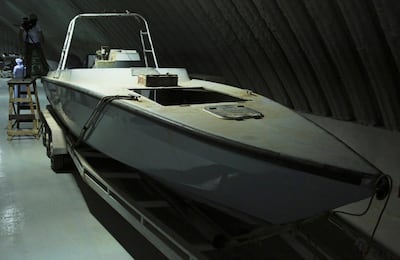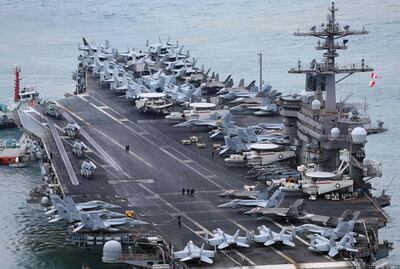The Iran-backed Houthis are relentlessly counter-attacking US ships in the Red Sea, after relaunching their naval blockade of the waterway, in protest against Israel’s renewed war in Gaza.
In the latest round of violence, following waves of US air strikes, the group claimed to have launched 18 anti-ship ballistic missiles at the USS Harry S Truman carrier strike group, saying they fended off an American attack.
The missiles barrel down from the thin atmosphere near space at colossal speeds. The group often claims to have hit US ships, including multibillion-dollar aircraft carriers, in attacks that are often accompanied by drone and cruise missiles at low level to place maximum stress on air defences.
Many of the low-level attacks are intercepted long before they reach US ships, as shown in the video below where a US plane uses an Advanced Precision Kill Weapon System II rocket to hit a Houthi drone.
US ships keep operating and deny successful strikes, although on one occasion the USS Gravely warship had to deploy a Phalanx weapon system to stop a low-flying cruise missile.
The gun tracks missiles at close range before blasting them with 4,500 explosive shells a minute. That means the Houthis certainly got close, perhaps seconds, from a catastrophic hit on a US vessel.
Warships armed with Phalanx can also use the gun to stop surface ships, in the event the Houthis tried to use an unmanned explosive drone boat to attack.
For an aircraft carrier such as the USS Dwight D Eisenhower, which was being guarded by the Gravely at the time of the Phalanx interception, there are often five warships providing protection, bristling with a range of air defence systems to target missiles at much longer ranges than the Phalanx.
The Houthis have, however, hit many civilian ships. But why is hitting the US Navy – and allied European military vessels – proving so hard for the group?
The Houthi kill chain
It comes down to what experts call the “kill chain”. This is, according to the US Navy, the process of “finding, fixing, targeting, tracking, engaging and assessing” the enemy over a long range.
The Houthis have been able to do this through assistance from Iranian spy ships, including the Behshad, and commercially available shipping data (the latter quite haphazardly, involving attacks on Russian ships). But there is currently no Iranian “spy ship” in the Red Sea.
For warships, there are complicating factors in homing in on targets, the first challenge in the kill chain being “finding”.
To understand how complex this is, the US recently used high-altitude balloons floating 15km over the Mariana Islands in the Pacific as sensors to complete a kill chain in a live-fire exercise to hit a moving decommissioned ship hundreds of kilometres away.
An unspecified drone, reportedly with “extreme endurance”, also took part in the exercise. The idea was that when a missile is fired over such long distances, data can be relayed to the missile in flight as the target moves. This is far harder than hitting a static site.
While the Houthis have numerous drones, as noted at the start of the article, they are vulnerable to being shot down by US aircraft. At sea, they lack a key advantage of drones, which is flying low through valleys, masking themselves from radar.
While exact locations of US vessels are not disclosed, there have been various reports that US aircraft carriers tend to operate in the northern part of the Red Sea.
This would be logical, because aircraft carriers like the USS Harry S Truman, with nearly 6,000 crew and air personnel on board and 90 aircraft, need heavy defending, with a ring of supporting warships, from long-range Houthi cruise missiles.
That immediately puts the carrier at the maximum range of the Houthis' Tankil anti-ship ballistic missile, assuming the group's claim to target the ship is accurate.
The Tankil, thought to be based on Iran's Raad-500, can supposedly reach Mach 8, or eight times the speed of sound.
If Iran's claims are correct, it would reach the Harry S Truman in about three minutes at maximum range, although the top speed is likely in midcourse, or fastest part of its flight, and the average speed will be much slower.
If the carrier was alerted to the missile launch – perhaps by US infrared early-warning satellites, which are used in this role – its AW4 nuclear reactors would propel the 100,000-tonne vessel at 55kph for 2.75km at the time the missile was plunging to the target area.
The Tankil however, would not (if working correctly) plunge passively into the sea, but has an on-board seeker, either radar or infrared (heat-seeking). This means that the Truman, or ships around it, could easily deploy electronic warfare to jam the seeker and send it even further off course.
It is not surprising, then, that both civilian ships and naval vessels in the Red Sea have reported Houthi missiles landing several kilometres from their ships.
Electronic warfare and other countermeasures, such as flares and “chaff”, that confuse missile seekers, have been used to stop Houthi low-flying cruise missile attacks. Anti-ship cruise missiles, unlike the ballistic anti-ship missiles, can also be shot down by jets.
A swarm of Houthi drones, likely to be detected long before they neared US ships by powerful airborne radar, were downed in this way.
To get an idea of how many missiles might be needed to destroy a US warship, Chinese estimates cited by Rusi, a UK defence think tank, say six cruise missiles and one anti-ship ballistic missile would be needed.
The Rusi analysis, however, notes that the calculation does not consider US countermeasures, such as electronic warfare, so the total for the Houthis could be higher – perhaps more than the 18 allegedly fired in one salvo.
The%20specs
%3Cp%3E%3Cstrong%3EEngine%3A%20%3C%2Fstrong%3E3.0-litre%20twin-turbo%20V6%0D%3Cbr%3E%3Cstrong%3ETransmission%3A%20%3C%2Fstrong%3E10-speed%20auto%0D%3Cbr%3E%3Cstrong%3EPower%3A%20%3C%2Fstrong%3E400bhp%0D%3Cbr%3E%3Cstrong%3ETorque%3A%20%3C%2Fstrong%3E563Nm%0D%3Cbr%3E%3Cstrong%3EPrice%3A%20%3C%2Fstrong%3EDh320%2C000%0D%3Cbr%3E%3Cstrong%3EOn%20sale%3A%3C%2Fstrong%3E%20Now%3C%2Fp%3E%0A
Innotech Profile
Date started: 2013
Founder/CEO: Othman Al Mandhari
Based: Muscat, Oman
Sector: Additive manufacturing, 3D printing technologies
Size: 15 full-time employees
Stage: Seed stage and seeking Series A round of financing
Investors: Oman Technology Fund from 2017 to 2019, exited through an agreement with a new investor to secure new funding that it under negotiation right now.
Company Profile
Name: Thndr
Started: 2019
Co-founders: Ahmad Hammouda and Seif Amr
Sector: FinTech
Headquarters: Egypt
UAE base: Hub71, Abu Dhabi
Current number of staff: More than 150
Funds raised: $22 million
Specs
Engine: Duel electric motors
Power: 659hp
Torque: 1075Nm
On sale: Available for pre-order now
Price: On request
Killing of Qassem Suleimani
The years Ramadan fell in May
UPI facts
More than 2.2 million Indian tourists arrived in UAE in 2023
More than 3.5 million Indians reside in UAE
Indian tourists can make purchases in UAE using rupee accounts in India through QR-code-based UPI real-time payment systems
Indian residents in UAE can use their non-resident NRO and NRE accounts held in Indian banks linked to a UAE mobile number for UPI transactions
HOW TO WATCH
Facebook: TheNationalNews
Twitter: @thenationalnews
Instagram: @thenationalnews.com
TikTok: @thenationalnews
UAE currency: the story behind the money in your pockets
25-MAN SQUAD
Goalkeepers: Francis Uzoho, Ikechukwu Ezenwa, Daniel Akpeyi
Defenders: Olaoluwa Aina, Abdullahi Shehu, Chidozie Awaziem, William Ekong, Leon Balogun, Kenneth Omeruo, Jamilu Collins, Semi Ajayi
Midfielders: John Obi Mikel, Wilfred Ndidi, Oghenekaro Etebo, John Ogu
Forwards: Ahmed Musa, Victor Osimhen, Moses Simon, Henry Onyekuru, Odion Ighalo, Alexander Iwobi, Samuel Kalu, Paul Onuachu, Kelechi Iheanacho, Samuel Chukwueze
On Standby: Theophilus Afelokhai, Bryan Idowu, Ikouwem Utin, Mikel Agu, Junior Ajayi, Valentine Ozornwafor
UFC%20FIGHT%20NIGHT%3A%20SAUDI%20ARABIA%20RESULTS
%3Cp%3E%0D%3C%2Fp%3E%0A%3Cp%3E%3Cstrong%3EMain%20card%3Cbr%3EMiddleweight%3A%3C%2Fstrong%3E%0D%3Cbr%3ERobert%20Whittaker%20defeated%20Ikram%20Aliskerov%20via%20knockout%20(Round%201)%0D%3Cbr%3E%3Cstrong%3EHeavyweight%3A%3C%2Fstrong%3E%0D%3Cbr%3EAlexander%20Volkov%20def%20Sergei%20Pavlovich%20via%20unanimous%20decision%0D%3Cbr%3E%3Cstrong%3EMiddleweight%3A%3C%2Fstrong%3E%0D%3Cbr%3EKelvin%20Gastelum%20def%20Daniel%20Rodriguez%20via%20unanimous%20decision%0D%3Cbr%3E%3Cstrong%3EMiddleweight%3A%3C%2Fstrong%3E%0D%3Cbr%3EShara%20Magomedov%20def%20Antonio%20Trocoli%20via%20knockout%20(Round%203)%0D%3Cbr%3E%3Cstrong%3ELight%20heavyweight%3A%3C%2Fstrong%3E%0D%3Cbr%3EVolkan%20Oezdemir%20def%20Johnny%20Walker%20via%20knockout%20(Round%201)%0D%3Cbr%3E%3Cstrong%3EPreliminary%20Card%0D%3Cbr%3ELightweight%3A%3C%2Fstrong%3E%0D%3Cbr%3ENasrat%20Haqparast%20def%20Jared%20Gordon%20via%20split%20decision%0D%3Cbr%3E%3Cstrong%3EFeatherweight%3A%3C%2Fstrong%3E%0D%3Cbr%3EFelipe%20Lima%20def%20Muhammad%20Naimov%20via%20submission%20(Round%203)%0D%3Cbr%3E%3Cstrong%3EWelterweight%3A%3C%2Fstrong%3E%0D%3Cbr%3ERinat%20Fakhretdinov%20defeats%20Nicolas%20Dalby%20via%20split%20decision%0D%3Cbr%3E%3Cstrong%3EBantamweight%3A%3C%2Fstrong%3E%0D%3Cbr%3EMuin%20Gafurov%20def%20Kang%20Kyung-ho%20via%20unanimous%20decision%0D%3Cbr%3E%3Cstrong%3ELight%20heavyweight%3A%3C%2Fstrong%3E%0D%3Cbr%3EMagomed%20Gadzhiyasulov%20def%20Brendson%20Ribeiro%20via%20majority%20decision%0D%3Cbr%3E%3Cstrong%3EBantamweight%3A%3C%2Fstrong%3E%0D%3Cbr%3EChang%20Ho%20Lee%20def%20Xiao%20Long%20via%20split%20decision%3C%2Fp%3E%0A
THE SPECS
Engine: 3.5-litre supercharged V6
Power: 416hp at 7,000rpm
Torque: 410Nm at 3,500rpm
Transmission: 6-speed manual
Fuel consumption: 10.2 l/100km
Price: Dh375,000
On sale: now
Film: Raid
Dir: Rajkumar Gupta
Starring: Ajay Devgn, Ileana D'cruz and Saurabh Shukla
Verdict: Three stars
Green ambitions
- Trees: 1,500 to be planted, replacing 300 felled ones, with veteran oaks protected
- Lake: Brown's centrepiece to be cleaned of silt that makes it as shallow as 2.5cm
- Biodiversity: Bat cave to be added and habitats designed for kingfishers and little grebes
- Flood risk: Longer grass, deeper lake, restored ponds and absorbent paths all meant to siphon off water
Springsteen: Deliver Me from Nowhere
Director: Scott Cooper
Starring: Jeremy Allen White, Odessa Young, Jeremy Strong
Rating: 4/5
COMPANY%20PROFILE
%3Cp%3E%3Cstrong%3ECompany%20name%3A%3C%2Fstrong%3E%20The%20Cloud%3C%2Fp%3E%0A%3Cp%3E%3Cstrong%3EStarted%3A%3C%2Fstrong%3E%202018%3C%2Fp%3E%0A%3Cp%3E%3Cstrong%3EFounders%3A%3C%2Fstrong%3E%20George%20Karam%20and%20Kamil%20Rogalinski%3C%2Fp%3E%0A%3Cp%3E%3Cstrong%3EBased%3A%3C%2Fstrong%3E%20Hub71%2C%20Abu%20Dhabi%2C%20UAE%3C%2Fp%3E%0A%3Cp%3E%3Cstrong%3EIndustry%3A%3C%2Fstrong%3E%20Food%20technology%3C%2Fp%3E%0A%3Cp%3E%3Cstrong%3EFunding%20size%3A%3C%2Fstrong%3E%20%2410m%2B%3C%2Fp%3E%0A%3Cp%3E%3Cstrong%3EInvestors%3A%3C%2Fstrong%3E%20Middle%20East%20Venture%20Partners%2C%20Olayan%20Financing%2C%20Rua%20Growth%20Fund%3C%2Fp%3E%0A
Which honey takes your fancy?
Al Ghaf Honey
The Al Ghaf tree is a local desert tree which bears the harsh summers with drought and high temperatures. From the rich flowers, bees that pollinate this tree can produce delicious red colour honey in June and July each year
Sidr Honey
The Sidr tree is an evergreen tree with long and strong forked branches. The blossom from this tree is called Yabyab, which provides rich food for bees to produce honey in October and November. This honey is the most expensive, but tastiest
Samar Honey
The Samar tree trunk, leaves and blossom contains Barm which is the secret of healing. You can enjoy the best types of honey from this tree every year in May and June. It is an historical witness to the life of the Emirati nation which represents the harsh desert and mountain environments
COMPANY%20PROFILE
%3Cp%3E%3Cstrong%3ECompany%3A%3C%2Fstrong%3E%20Eco%20Way%3Cbr%3E%3Cstrong%3EStarted%3A%3C%2Fstrong%3E%20December%202023%3Cbr%3E%3Cstrong%3EFounder%3A%3C%2Fstrong%3E%20Ivan%20Kroshnyi%3Cbr%3E%3Cstrong%3EBased%3A%3C%2Fstrong%3E%20Dubai%2C%20UAE%3Cbr%3E%3Cstrong%3EIndustry%3A%3C%2Fstrong%3E%20Electric%20vehicles%3Cbr%3E%3Cstrong%3EInvestors%3A%3C%2Fstrong%3E%20Bootstrapped%20with%20undisclosed%20funding.%20Looking%20to%20raise%20funds%20from%20outside%3Cbr%3E%3C%2Fp%3E%0A
COMPANY%20PROFILE
%3Cp%3ECompany%20name%3A%20CarbonSifr%3Cbr%3EStarted%3A%202022%3Cbr%3EBased%3A%20Dubai%3Cbr%3EFounders%3A%20Onur%20Elgun%2C%20Mustafa%20Bosca%20and%20Muhammed%20Yildirim%3Cbr%3ESector%3A%20Climate%20tech%3Cbr%3EInvestment%20stage%3A%20%241%20million%20raised%20in%20seed%20funding%3Cbr%3E%3C%2Fp%3E%0A
What is safeguarding?
“Safeguarding, not just in sport, but in all walks of life, is making sure that policies are put in place that make sure your child is safe; when they attend a football club, a tennis club, that there are welfare officers at clubs who are qualified to a standard to make sure your child is safe in that environment,” Derek Bell explains.
UAE v Gibraltar
What: International friendly
When: 7pm kick off
Where: Rugby Park, Dubai Sports City
Admission: Free
Online: The match will be broadcast live on Dubai Exiles’ Facebook page
UAE squad: Lucas Waddington (Dubai Exiles), Gio Fourie (Exiles), Craig Nutt (Abu Dhabi Harlequins), Phil Brady (Harlequins), Daniel Perry (Dubai Hurricanes), Esekaia Dranibota (Harlequins), Matt Mills (Exiles), Jaen Botes (Exiles), Kristian Stinson (Exiles), Murray Reason (Abu Dhabi Saracens), Dave Knight (Hurricanes), Ross Samson (Jebel Ali Dragons), DuRandt Gerber (Exiles), Saki Naisau (Dragons), Andrew Powell (Hurricanes), Emosi Vacanau (Harlequins), Niko Volavola (Dragons), Matt Richards (Dragons), Luke Stevenson (Harlequins), Josh Ives (Dubai Sports City Eagles), Sean Stevens (Saracens), Thinus Steyn (Exiles)
THE SPECS
Engine: 1.5-litre
Transmission: 6-speed automatic
Power: 110 horsepower
Torque: 147Nm
Price: From Dh59,700
On sale: now
The Details
Article 15
Produced by: Carnival Cinemas, Zee Studios
Directed by: Anubhav Sinha
Starring: Ayushmann Khurrana, Kumud Mishra, Manoj Pahwa, Sayani Gupta, Zeeshan Ayyub
Our rating: 4/5
UAE currency: the story behind the money in your pockets






